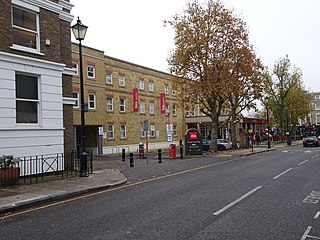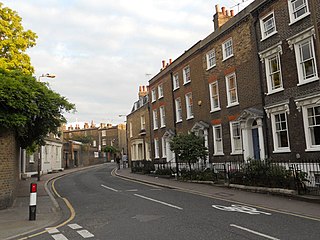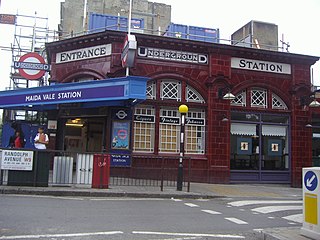
Keston is a village in Greater London, England, located within the London Borough of Bromley, Greater London. Prior to 1965 it was within the historic county of Kent. It is part suburban, part rural in nature and lies on the edge of Hayes Common, just beyond the London conurbation to the south of Bromley Common. It includes the small hamlet of Nash to the southwest. The northern, more suburban part of Keston is sometimes referred to as Keston Mark.

Woolwich is a town in southeast London, England, within the Royal Borough of Greenwich.

Greenwich is an area in south-east London, England, within the ceremonial county of Greater London, 5.5 miles (8.9 km) east-south-east of Charing Cross.

Greenwich Park is a former hunting park in Greenwich and one of the largest single green spaces in south-east London. One of the Royal Parks of London, and the first to be enclosed, it covers 74 hectares, and is part of the Greenwich World Heritage Site. Surrounding the hilltop Royal Observatory and straddling the Greenwich Prime Meridian, it commands elevated views over the River Thames, the Isle of Dogs and the City of London.
George Smith was an English architect and surveyor of the early 19th century, with strong connections with central and south-east London.

Woolwich Common is a common in Woolwich in southeast London, England. It is partly used as military land and partly as an urban park. Woolwich Common is a conservation area. It is part of the South East London Green Chain. It is also the name of a street on the east side of the common, as well as an electoral ward of the Royal Borough of Greenwich. The population of the ward at the 2011 Census was 17,499.

Grosvenor Road station was a railway station in London located at the north end of Grosvenor Bridge on the approach tracks to Victoria station. Victoria station was originally operated as two separate parts served by the London, Chatham and Dover Railway (LC&DR) and the London, Brighton and South Coast Railway (LB&SCR) and Grosvenor Road station was also operated in this way. The LC&DR station operated between 1867 and 1911 and the LB&SCR station operated between 1870 and 1907. The station building of the LC&DR station remains on the eastern side of the tracks adjacent to Grosvenor Road (A3212) although no platforms remain at the elevated track level.

Greenwich Park was a railway station opened in 1888 by the London, Chatham and Dover Railway (LCDR) in Greenwich, south-east London. The station was originally called Greenwich and the LCDR intended it to rival a nearby station also named Greenwich which was owned by the South Eastern Railway (SER) and which had opened over 50 years earlier. The LCDR's station was the terminus of a branch line from Nunhead.

Leslie H. Kemp and Frederick E. Tasker were English architects who practiced in the 1930s as Kemp & Tasker.

Bathway Quarter is an area of historic interest in the centre of Woolwich, South East London. Most buildings in the Bathway Quarter are Grade II*, Grade II or locally listed, while the area as a whole is designated a conservation area by Greenwich Council. With the exception of the Old Town Hall, the listed buildings date from the late-19th or early-20th century. Several were designed by local architect Henry Hudson Church, their civic use reflected in their grand elevations formed of red brick with stone detailing.

Powis Street is a partly pedestrianised shopping street in Woolwich in the Royal Borough of Greenwich, south-east London, England. It was laid out in the late 18th century and was named after the Powis brothers, who developed most of the land in this part of the town. The street has been rebuilt several times but has retained some notable examples of late-Victorian and Art Deco architecture. Since 2019 the street is part of a conservation area.

Old Woolwich or Woolwich Central Riverside is an area along the Thames in Woolwich, South East London. It is the oldest inhabited part of Woolwich, going back to an Anglo-Saxon riverside settlement. When the demographic centre of Woolwich shifted south in the 1800s, the area became a Victorian slum. Most of Old Woolwich was cleared in the 20th and early 21st centuries to make way for industrial, infrastructural and other large-scale developments. Although most of the earlier buildings have been demolished, the area has retained some interesting architecture, including the Georgian parish church, the Edwardian foot tunnel rotunda and two cinemas of the 1930s.

John Dixon Butler was a British architect and surveyor who had a long, professional association with London's Metropolitan Police. During his 25-year career with the police, he completed the designs and alterations to around 200 police buildings, including ten courts; as of 2022, about 58 of his buildings survive. Historic England describes him as "one of the most accomplished Metropolitan Police architects" and have included around 25 of his buildings on the National Historic List of England and Wales.

King William Walk is a street in central Greenwich in London. It runs northwards from the entrance to Greenwich Park along the edge of the Old Royal Naval College to the Cutty Sark and the nearby Greenwich foot tunnel. The western side of the street comprises a mixture of residential and commercial properties, with several shops, restaurants and, south of Nelson Road, two pubs. The eastern side includes the Discover Greenwich Visitor Centre and several former College buildings and open spaces today used by the University of Greenwich, including residential accommodation in Devonport House, south of Nelson Road.

Greenwich Church Street is a street in central Greenwich in South East London. It diverges from Greenwich High Road at St Alfege Church and curves north through the commercial centre of the town until it reaches the Cutty Sark by the River Thames. College Approach branches off it east towards King William Walk and the Old Royal Naval College. It is located in the middle of what was medieval Greenwich. Its current configuration dates back to the redevelopment of Greenwich in the 1820s by the architect Joseph Kay, but is based on a much older road marked as Greenwich High Street or Church Street on a late seventeenth century map. It runs through the heart of central Greenwich, close to the Cutty Sark DLR station, and has many shops and restaurants. An entrance to Greenwich Market is located on the east side of the street.

Royal Hill, Greenwich is a mainly residential street, approximately 0.7 km (0.4 mi) long, in Greenwich in South London. It runs uphill off Greenwich High Road in a southwards curve and then westwards to meet Greenwich South Street. At the northern end of the road is Greenwich Town Hall, a 1939 Art Deco building designed by Clifford Culpin. A number of Georgian era houses are located along the road. The Pevsner Guide describes much of the road as "the usual suburban expansion" which was "filling in between the more scattered eighteenth century houses". Royal Hill was once the name of the entire hill rather than just the street, and so other roads in the area are historically referred to as Royal Hill, including Point Hill which ascends south towards Blackheath.

Randolph Avenue is a street in Maida Vale in London. Located in the City of Westminster, it is a long avenue running from north to south. The southern end is located in Little Venice near to the Paddington branch of the Grand Union Canal. The street runs northwards, crossing Clifton Gardens, Sutherland Avenue, Elgin Avenue and Carlton Vale. The road then continues as Randolph Gardens until it meets Kilburn Park Road. The Edgware Road runs directly parallel to Randolph Avenue to the east.

Belsize Lane is a street in the Belsize Park area of Hampstead in London. Located in the London Borough of Camden, it runs east to west from Haverstock Hill to Fitzjohns Avenue. While residential for much of the route, it also features a group of commercial properties that form the centre of Belsize Village. The Tavistock Clinic is located at its western end.

Pond Street is located in Hampstead in the London Borough of Camden. It runs eastwards from Rosslyn Hill to South End Green, located in the old "South End" of the settlement. The street takes its name from an ancient pond at South End Green, a source of the River Fleet, and has been known by this name since at least 1678. The pond survived into the Victorian era.



















